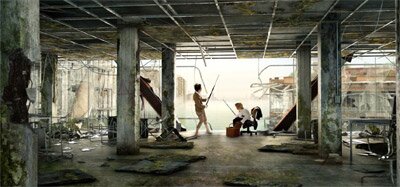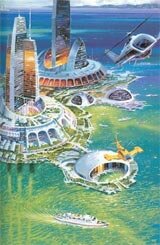

Floods or their imminent threat plagued the world last month from southern China to areas surrounding the Mississippi. While their effect on the natural landscape maybe temporary, 2004’s catastrophic Tsunami resulted in permanent coastal changes. With an accelerating increase in rising ocean levels, we can expect earth’s landscape to change more dramatically. At current rates, the Maldives will vanish before century’s end.
In popular media, engineering and architecture don’t offer salvation. Flooded urban landscapes provide a dramatic backdrop where those that survive… adapt. A watershed London serves as backdrop in FreakAngels, “a free, weekly, ongoing comic written by Warren Ellis (Transmetropolitan, Global Frequency, Desolation Jones) and illustrated by Paul Duffield”. FreakAngels opens with a startling pane featuring London’s disintegrating Houses of Parliament engulfed by water (Top Image). Elevated water levels have startling transformative effects on architecture. Witnessing the Richard Rogers designed Millennium (O2) Dome jutting out of the water in episode thirteen brings forth fascinating possibilities; one character declares “I could have turned it into a great big solar still”.
An exhibition at the London Festival of Architecture, now in its final days, depicts London Flooded in 2090 as envisioned by multi-disciplinary film and media production studio, Squint/Opera. A series of Lightbox images created using “photography, 3d modeling and digital manipulation - imitate techniques of the super-idealistic Victorian landscape painters” and capture “snapshots of people going about their lives, long since having adapted to the worlds new circumstance”, enjoying a “tranquil utopia with the architecture of the distant rat race suspended below the water.”
“The people in each scene appear to be relaxed and happy in their environment and in the first we see a man who has rowed into St Pauls and is preparing to dive off the ledge of the whispering gallery into the dimly lit ’swimming pool’. Another sees the upper reaches of a once famous art gallery where people have collected pre flood artifacts and are rigging them up to get makeshift machinery going to power a light bulb. We assume that the world is a much less complicated and that there is not much in the way of industrialized manufacture. The original City is shown as the now abandoned Canary Wharf where two women are fishing out of the side of an office and the sail of a boat going down the street [shown above].”
For centuries humanity has held back the surge of water with a myriad of iconic design & engineering marvels from the drainage mills of Holland to the Thames Barrier, the only distinctly recognizable landmark in the recent film Eastern Promises.
Pilotis were integral to the designs of Architect Le Corbusier. Protection from flood waters was an added benefit.
Levees have held back mighty rivers like the Mississippi. However there’s folly inherent in the reliance of levees along rivers far from an outlet where floodplains have since been developed. The strangled river waters rise, their flow accelerating, increasing the destructiveness of the inevitable.
Economic forces have resulted in a floodplain development boom. Emily Gertz on Grist reports: “Once it was a cornfield; now it’s a Wal-Mart, a Taco Bell, a Target. Here along a stretch of Missouri’s Highway 40, in the Chesterfield Valley area just west of downtown St. Louis, what’s said to be the largest strip mall in the country sits on about 46 acres of Mississippi River bottomlands. Less than 20 years ago, the land was open space.”
If more particular urban planning can penetrate the political and economic forces, perhaps the future will bring urban landscapes capable of sustaining floods.






